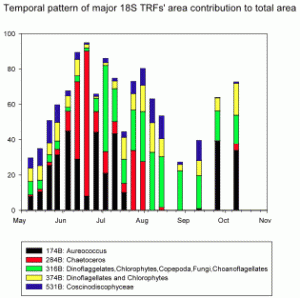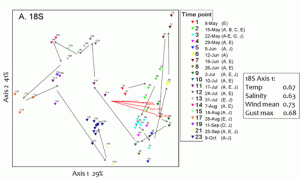Jackie Collier, Yuan Liu
Further Information
https://sites.google.com/a/stonybrook.edu/collier-lab2/
 The structure of the planktonic community of Great South Bay is determined by a variety of factors, including the physical forces that drive the Bay’s hydrology, the supply of nutrients from within the Bay and from the watershed, and the benthic communities that interact with the water column. In turn, whether the planktonic community is dominated by nutritious phytoplankton such as diatoms or by harmful algae such as Aureococcus anophagefferens can have dramatic effects on the rest of the ecosystem. In an effort to better understand these interactions, we collected water samples from a transect across Great South Bay (see map) weekly or biweekly throughout most of 2008 (a brown tide year) and 2009. We used a molecular genetic method known as terminal restriction fragment length polymorphism (TRFLP) to profile (or ‘fingerprint’) both the eukaryotic and prokaryotic plankton via their small subunit ribosomal RNA genes. The TRFLP profiles from 2008 showed clearly the high contribution of A. anophagefferens to the community during early summer and fall (see column figure), and were consistent with standard counts of brown tide cell abundance (performed by Suffolk County Department of Health). Statistical analyses of the TRFLP profiles have revealed that the plankton community usually changes smoothly from week to week (see biplot figure), although there are some large jumps. The dates with the highest A. anophagefferens abundance tend to group together (lower right hand corner of the plot). We have also found that the plankton community is usually very similar all across the sampling transect, although in some weeks it can be quite different on the Long Island and Fire Island sides of GSB. Temperature, salinity, and wind are strongly associated with Axis 1, which explains 29% of the variation in community structure, but we do not yet know what factors are associated with the rest of the variation (e.g., 41% explained by Axis 2). When combined with the other GSB projects, these temporal and spatial patterns in planktonic community structure will provide new insights into the function of the GSB ecosystem.
The structure of the planktonic community of Great South Bay is determined by a variety of factors, including the physical forces that drive the Bay’s hydrology, the supply of nutrients from within the Bay and from the watershed, and the benthic communities that interact with the water column. In turn, whether the planktonic community is dominated by nutritious phytoplankton such as diatoms or by harmful algae such as Aureococcus anophagefferens can have dramatic effects on the rest of the ecosystem. In an effort to better understand these interactions, we collected water samples from a transect across Great South Bay (see map) weekly or biweekly throughout most of 2008 (a brown tide year) and 2009. We used a molecular genetic method known as terminal restriction fragment length polymorphism (TRFLP) to profile (or ‘fingerprint’) both the eukaryotic and prokaryotic plankton via their small subunit ribosomal RNA genes. The TRFLP profiles from 2008 showed clearly the high contribution of A. anophagefferens to the community during early summer and fall (see column figure), and were consistent with standard counts of brown tide cell abundance (performed by Suffolk County Department of Health). Statistical analyses of the TRFLP profiles have revealed that the plankton community usually changes smoothly from week to week (see biplot figure), although there are some large jumps. The dates with the highest A. anophagefferens abundance tend to group together (lower right hand corner of the plot). We have also found that the plankton community is usually very similar all across the sampling transect, although in some weeks it can be quite different on the Long Island and Fire Island sides of GSB. Temperature, salinity, and wind are strongly associated with Axis 1, which explains 29% of the variation in community structure, but we do not yet know what factors are associated with the rest of the variation (e.g., 41% explained by Axis 2). When combined with the other GSB projects, these temporal and spatial patterns in planktonic community structure will provide new insights into the function of the GSB ecosystem.





